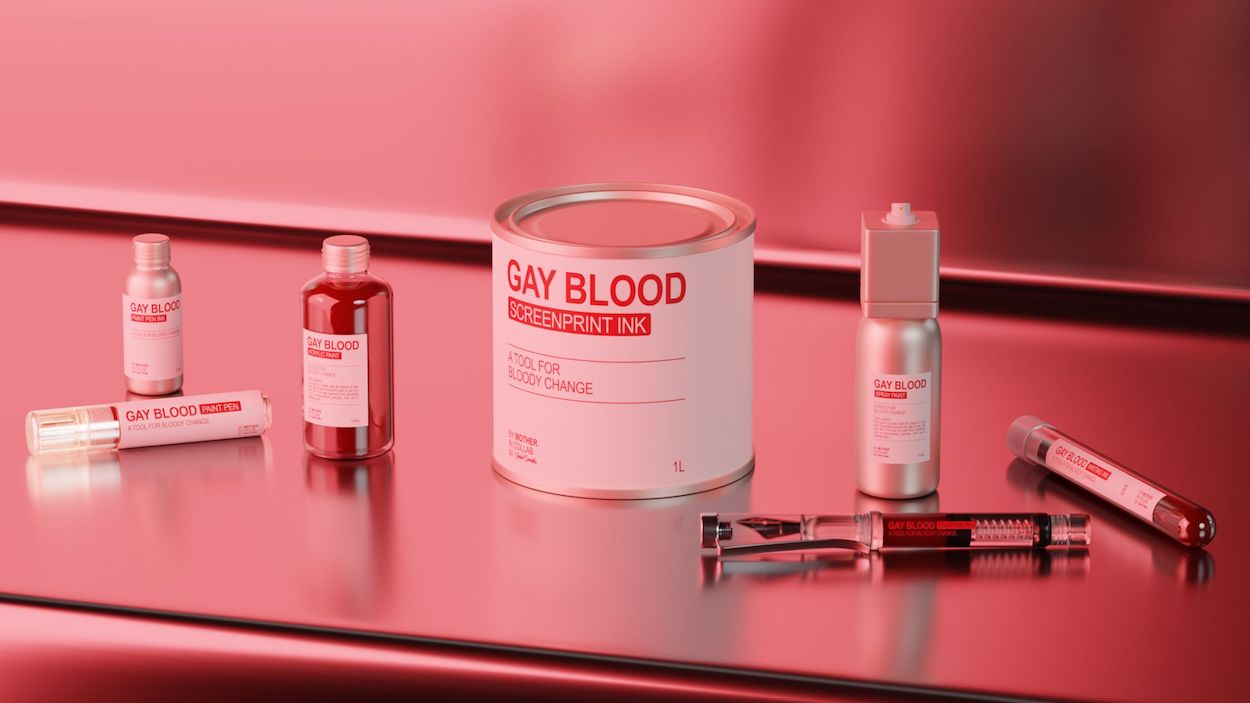
In the early ‘80s, at the height of the AIDS crisis, the U.S. government placed a lifetime ban on “men who have sex with men” from donating blood. The restriction, they reasoned, intended to keep HIV out of the blood supply. It wasn’t until 2015 that—after rebukes from advocates and lawmakers—the FDA replaced the ban with a one-year abstinence requirement, further reducing it to three months in April 2020 as the country grappled with a pandemic-induced blood shortage. Fast forward two years and the shortage has only intensified—the Red Cross reported a one-day supply of critical blood types due to a 10 percent decline in donations.
Confounded by the ongoing injustice of the restrictions on healthy gay men, the artist Stuart Semple teamed with creative agency Mother to print a series of T-shirts with ink made from their blood. That initiative continues with the launch of a blood-infused paint collection, which includes a fountain pen, screen printing ink, acrylic paint, spray paint, and a marker. Semple hopes people use the deep-red supplies to protest the FDA’s policies, which critics call outdated and homophobic. All proceeds from sales will benefit the Callen-Lorde Community Health Center, a New York primary care facility serving LGBTQ+ communities.
Semple knows a thing or two about color. He provoked one of the more entertaining art-world riffs in recent memory by replicating Vantablack—the world’s blackest hue—after Anish Kapoor licensed exclusive artistic rights to it. Semple mocked him by launching the world’s “pinkest pink” paint, causing Kapoor to flip him the bird on Instagram. This past year, Semple debuted $19 bottles of Blink, a mega-matte “superblack” ink, which he recommends for calligraphy and paint markers. He even concocted an acrylic paint in the coveted Tiffany Blue, which the luxury jewelry brand has protected through extreme trademark rights since 1837. The stunt caused one critic to dub Semple the “Robin Hood of the Rainbow.”
Adept at mixing pigments and democratizing color, Semple had his work cut out for him when formulating the Gay Blood Collection—it turns out that our vital fluids don’t make the most effective colorants. Blood can grow bacteria if stored improperly and turns brown when exposed to air. Trace amounts of actual blood were used in the final mixture, which includes a blend of both mineral and synthetic pigments. “I’m not relying on [the blood] to boost the color or make it stick,” he says. “I’m relying on it to convey meaning.”
The collection upholds a longstanding tradition of activists using colors to give their causes visual impact. Different tones wield a spectrum of influence over human behavior and elicit emotions—red, for example, induces feelings of passion and danger, while black signifies mourning and mystery. The phenomenon, referred to as the Color Revolution, has roots in the Philippines, where supporters of Benigno Aquino Jr. tied yellow ribbons along the streets of Manila to welcome him home from self-exile in the mid-‘80s.
In recent years, Women’s March protesters donned pink knitted pussyhats to protest Donald Trump’s misogynistic statements the day after his presidential inauguration while the Black Lives Matter movement’s main symbol is a black raised and clenched fist. After the Polish government placed restrictions on abortion, pro-choice activists united behind a red lightning bolt as a symbol of protest; the color was also used in costumes to evoke the Margaret Atwood novel and hit TV show Handmaid’s Tale as a protest against the overturning of Roe v. Wade. In 2018, French citizens wore yellow safety vests to voice displeasure with fuel taxes that strained working-class incomes.
“Color’s emotive, and if you spend any time looking at art, put yourself in front of a Van Gogh, put yourself in front of a Rothko, you feel something,” Semple says. “When we saw those wonderful women’s marches, with that bright pink color on those banners—can you imagine that being as potent without that color being used?”








